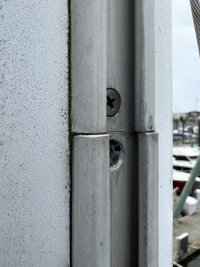The Bainbridge Allslip slides worked wonderfully. The ones I had were installed by the sailmaker. You’ll need to remove the webbing straps that hold your current slides and resew the straps with the new slides installed, and that will take a hefty sewing machine. I would apply McLube to the track every spring and that helped keep the track slippery.
However, because of an Ericson design flaw, I switched to the Tides SailTrack system last year. When I tried to raise the main for the first time last spring, I could not get the main up more than about 1/3 of the way. It hit a hard stop and would not go any further. Investigating, I found this:

The Ericsons with a Kenyon mast have an external extruded channel for the mainsail slides, but the channel sections are not long enough to reach the entire length of the mast. The butt joint on my mast is right below the lower spreader, and that is exactly where the mainsail would stop. The small offset you see between the two track sections is enough to keep the slide from going up further.
There is a pair of machine screws at the junction to keep the two sections aligned. As you can see on my mast, the head of the lower machine screw is missing. I used a skewer to probe inside the screw hole and could feel the shaft of the machine screw. Apparently the head of the machine screw snapped off, leaving the rest of the screw shank inside.
Since this is a stainless steel screw in aluminum, I knew they would be corroded together and I would not be able to back out the screw shank from the mast threads. The electrical wiring channel for the mast is immediately behind the mast track, so I was not willing to attempt to drill out the existing screw shank and retap a larger hole for another machine screw.
My next door slip mate has an Ericson 35-3, and I asked him if he had ever seen this problem. He said, "Oh, yeah! I go up the mast every spring and hammer the track sections back together again." I think he is missing both machine screws. I would surmise our winter gales flex the masts enough that the mast track sections get misaligned during the storms. His experience says that, once the machine screws are gone, this is going to be an ongoing problem. Apparently the once a year hammer realignment is sufficient for his boat.
We all have different levels of tolerance for surprises. I did not want to have the mast track sections become misaligned at an inconvenient moment. So I chose to switch to a Tides SailTrack system. It would give me one continuous track for the length of the mast and bridge the splice in the existing mast track.
If your mast track splice still has two intact machine screws, then the Bainbridge Allslip slides are an excellent option. Keep the track lubed with McLube, and inspect the machine screws at the butt joint yearly.

